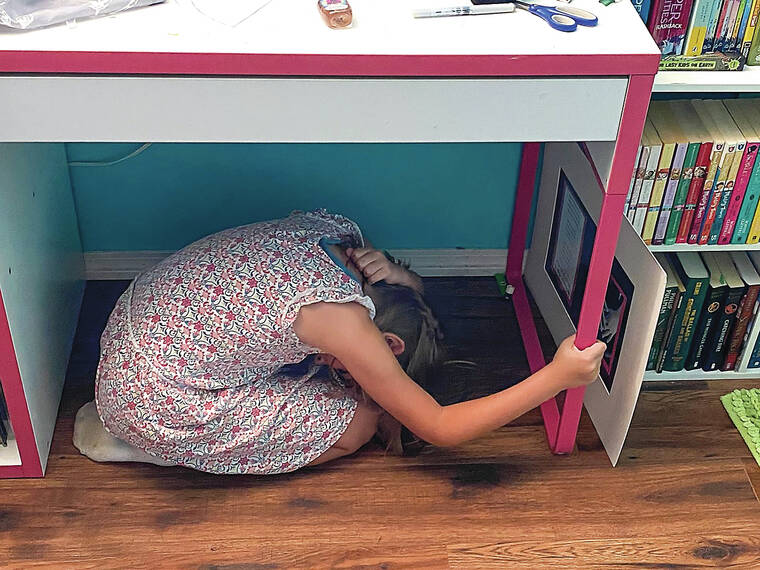From Ni‘ihau to Kilauea, all Hawaii residents live on landscapes shaped by volcanoes. Each Hawaiian volcano starts on the floor of the Pacific Ocean. Over time—and with countless eruptions—lava accumulates as the volcano grows above sea level, eventually creating the islands we now call home.
Beyond the inhabited islands are numerous other volcanic piles weighing down on the ocean bottom. To the southeast is Kama‘ehuakanaloa (formerly Lo‘ihi Seamount), a young submarine volcano that has yet to come up for air. Stretching far to the northwest, beyond Ni‘ihau to Mokupapapa (Kure Atoll), are mostly eroded volcanoes that make up the Papahanaumokuakea Marine National Monument.
To give a perspective of the immense mass sitting on the Pacific plate, the tallest of these volcanoes, Mauna Kea, is nearly a mile taller than Mount Everest from the base to the summit. The distance from Mokupapapa to Kama‘ehuakanaloa, is about 1,600 miles. With the addition of the Emperor Seamounts, which stretch even farther to the northwest, that length increases to 3,900 miles. That is a lot of lava, stacked far and tall.
Although infrequent, the broad and rigid oceanic plate bends and buckles under the immense weight of these islands. Earthquakes of this type can be compared to the creaks you might hear when walking on an old wooden lanai. The floor is merely reacting to the load placed upon it.
These types of earthquakes are typically deep and do not generate tsunamis. The water column needs to be displaced by a fault breaching the seafloor, not just shaken by an earthquake, for a tsunami to occur.
Some of the impacts from earthquakes, like the recent magnitude-6.2, can be minimized when we prepare in advance.
There are countless small actions we can do, long before another earthquake strikes, to protect ourselves, our ‘ohana, and our property. Make a plan and build a supply kit that can be used in case of an emergency. Fastening heavy objects like a bookcase or television to the wall will lessen the chances of them tipping over. Having sturdy latches on cupboards will help stop dishes from flying across the kitchen. These are just a couple of the small things we can do to prepare. Check out https://www.shakeout.org/hawaii to find out what else can be done.
The USGS Hawaiian Volcano Observatory, along with thousands of residents across the State, participate yearly in The Great Hawaii ShakeOut to raise awareness for earthquake preparedness.
International ShakeOut Day is the third Thursday of every October. The Thursday date also determines the time when we practice what to do during an earthquake. This year, on at 10:21 a.m. Thursday, Oct. 21, we invite you to Drop, Cover, and Hold On with us.
Tag us (@USGSVolcanoes) on Twitter, Facebook, or Instagram and show us how Hawaii does ShakeOut. Because the last magnitude-6.0 earthquake will not be the last magnitude-6.0 earthquake.
There were 11 events with three or more felt reports in the Hawaiian Islands during the past week. Listed here are the felt events with magnitudes of 3 and above: a magnitude-3.0 earthquake 1 miles south of Pahala on Oct. 12 at 6:35 a.m., a magnitude-3.0 earthquake 3 miles east-northeast of Pahala on Oct. 10 at 10 p.m., a magnitude-4.3 earthquake 13 miles south of Naalehu on Oct. 10 at 11:53 a.m., a magnitude-6.2 earthquake 16 miles south-southeast of Naalehu on Oct. 10 at 11:48 a.m., a magnitude-3.6 earthquake 4 miles east-northeast of Pahala on Oct. 9 at 1:08 p.m., and a magnitude-3.5 earthquake less than a mile south of Pahala on Oct. 7 at 8:25 p.m.
Volcano Watch is a weekly article and activity update written by U.S. Geological Survey Hawaiian Volcano Observatory scientists and affiliates. Visit https://www.usgs.gov/observatories/hawaiian-volcano-observatory for past Volcano Watch articles, Kilauea and Mauna Loa updates, volcano photos, maps, recent earthquake info, and more. Email questions to askHVO@usgs.gov.



